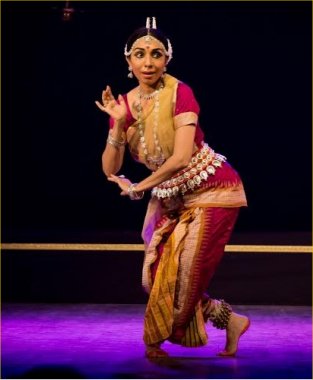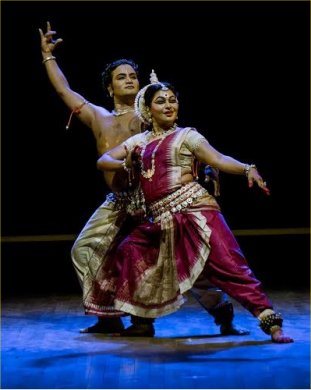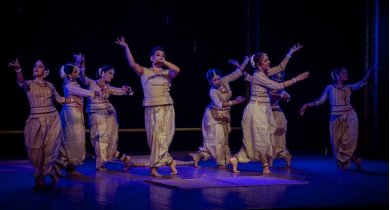
|   |

|   |
 e-mail: sunilkothari1933@gmail.com Sanjali's tribute on Guru Kelucharan Mohapatra's 13th death anniversary Photos courtesy: Sanjali April 18, 2017 On 7th April on the 13th death anniversary of Guru Kelucharan Mohapatra, his disciple Sharmila Mukerjee presented Pravaha as tribute at ADA Rangamandira in Bangalore. She has been organizing it every year for past ten years. This year she had worked on the character of Kaikeyi from Ramayana, inviting Pandit Nityananda Mishra to write the libretto in Sanskrit. It was a book of English poems which had set her thinking about the royal queen of Dasharatha. She felt that perhaps Kaikeyi is the most misunderstood character in Valmiki's epic Ramayana. She wanted to go beyond stereotyping her as an evil queen and explore various shades of her character. She went to Bhubaneswar and met Nityananda Mishra who responded with enthusiasm to her proposal and wrote the libretto which was set to music in Ragamalika and Talamalika by Bijay Jena, with rhythm by Dhaneswar Swain. The production began with Kaikeyi's old age, reminiscing about her earlier life as a warm hearted, complex woman, who loved Rama as much as her own son Bharata. She was a warrior, brave woman, who had on battlefield at the right moment helped King Dasharatha and saved him. In English, Sharmila gave the outline of Kaikeyi's persona in a nutshell. Using the Odissi vocabulary she portrayed the young, beautiful Kaikeyi, favourite of King Dasharatha, strong willed, stubborn, passionate but also slightly confused. She was very fond of Rama from his very childhood and used to play with him carrying him on her back. This sequence was from the choreography of Kelubabu depicting child Krishna with mother Yashoda and looked attractive. In her ekaharya lasyanga, one character playing various roles though dressed in the same costume, she cleverly impersonated character of Kaikeyi's maid Manthara, who planted in her mind unpleasant doubts telling her that if Rama were to be King, his mother Kaushalya would become Rajamata and favourite of the King and she would be relegated to the status of a maid. Instead she should see that her own son Bharata becomes the king and banish Rama to forest for 14 years! Initially Kaikeyi is confused and does not want to believe Manthara's suggestion, but is overcome about losing her status as a favourite queen. In the battle field when she had saved Dasharatha, he had granted her two boons. She had then told him that after the war was over, when she felt like, she would ask him to fulfill those two promises. Manthara reminded her of those two promises the King had given her. When Dasharatha came to Kaikeyi's chamber to share the happiness of Rama's coronation, he saw her crying, her ornaments thrown on the floor. When he asked the reason for her unhappiness, Kaikeyi asked for her two boons, leaving Dasharatha shocked and heartbroken. Sharmila has used the dialogue in vachikabhinaya which looked very dramatic: Maharaja Bharato bhava dhruvam. On hearing this calamity and Dasharatha's death, Bharata curses his mother - Dushtabuddhi janani na me tvam - you are not fit to be my mother - and Bharata goes to Panchavati to beg Rama to return. Their meeting is very touching. Rama tells him, Matru devo bhava, and not hold it against Kaikeyi and that he will observe his father's instructions. Bharata should go back to Ayodhya. Kaikeyi as an old woman in this production takes us through series of flashbacks from specific episodes of Ramayana. It is a 35 minute brief solo production and is connected with narration by Sharmila. Nityananda Mishra and Sharmila have focused on human nature of these characters. Sharmila has attempted to re-examine our readings and notions about the well known characters. Whereas one compliments both the script writer and Sharmila, I would suggest that the narration in later part of the presentation be made on recording off the stage, and not by Sharmila. She would better continue her enactment without breaking the performance with commentary. Since the kathavastu, the story is well known, she need not tell it in English. The simple Sanskrit text of the poem is self explanatory. Her loneliness in old age is well depicted and movingly enacted by her.  Sharmila Mukerjee  Lingaraj Pradhan and Sanjukta Dutt Pradhan After her solo, from Bhubaneswar the dancing duo, the husband and wife team of Lingaraj Pradhan and his wife Sanjukta Dutt Pradhan, disciples of Guru Gangadhar Pradhan, performed Shivapanchaka, with exquisite poetic allusions, describing the beauty of Lord Shiva with divya kundala, the ear ornaments, cool moon on forehead, resplendent necklace, holding trident, adorned with Kaustubha jewel, the devotee begging, "O Shivapati, Parvati pati, protect me from the ocean of this life/sansara." Both of them performed with excellent coordination, perfect synchronization and rendered Shivapanchaka feelingly. The dramatic elaboration of Panchabana by Kamadeva, Shiva's opening the eyes, falling on Parvati, Kama succeeding in his aim, Shiva's enchantment looking at Parvati and the shower of flowery arrows were performed well. The moment Shiva realized that he was disturbed, he opened his third eye and turned Kamadeva into ashes. The agony of Kamadeva was poignant. Both the dancers displayed sophistication and professional approach in their duet. There was clarity of Guru Gangadhar's bani. The second piece in praise of Goddess Bhavani choreographed by Bichitrananda Swain had several iconic images. Suddhamurty, Shubhamandalam, Chidanandarupam, Kodanda pashakunsha, lasat bahu dande etc., epithets found felicitous depiction recreating the beauty of the goddess. The devotees praying for release from distress, from the forest of the life Trahi Bhadre, Namaste Bhavani resonated well and both looked immersed in the feeling of devotion. Their costumes were well designed and both have attractive stage presence. Well trained in the Odissi idiom they acquitted themselves with the fame they have earned. The finale titled Karuna was by Ileana Citaristi on theme of Mother Teresa. Compassion was the central motif. Her five female dancers and male dancer Saswat Joshi performed to Ileana's choreography highlighting the intent of Mother's life message. The groupings were imaginative, uncluttered, with simple Odissi movements to Laxmikant Palit's melodious music and libretto by Chhotray. The unfortunate, distressed persons, all over, in the caves, forest, suffering and the compassion for them flowing from mother's heart was suggestively conveyed. The scene in which Saswat is lying on the floor, and mother lifts his body and places his head on her lap, offering water to him, was very moving. Ileana has used grass mats with imagination; like the screens they are used by dancers and spread on the floor. The image of the drop of water –bindu meets the ocean, similarly the drop of compassion spreads everywhere. 
Ileana Citaristi and group
Ileana has used the English text of Mother Teresa and the same content
is sung in Odiya poetry in musical notes with great effect. To suggest
Mother Teresa and her inmates, she has used sarees with three blue
borders which Mother Teresa wore, dancers holding and running from front
stage to back stage, with effective good lighting. They do not wear the
sarees. It is only suggested. Mother's words, "Life is an opportunity,
hold it, life is beauty, adorn it, life is a dream, make it real, life
is love, enjoy it, life is sadness, overcome it, life is joy, savour it,
life is cross, embrace it. Life is life, protect it," resonate with
compassion. The theme is so powerful that it transcends the technique of
Odissi and touches our hearts. Ileana has shown over the years her
desire to extend the boundaries of Odissi with thematic content and
succeeded with considerable success. Karuna is one of her well
conceived, choreographed works.In Bangalore since 2004 Sharmila has established her institution Sanjali and trained several young dancers in Odissi. Very industrious and with support from various well wishers and local Odiya community, she is rendering good service to Odissi dance form. Last year she had presented theme on trees and environment with her disciples, seeking and extending horizons of Odissi. This year presenting solo, duet and group choreography, she brought variety of the form in a meaningful manner.  Dr. Sunil Kothari is a dance historian, scholar, author and critic. He is honored with Padma Shri, Sangeet Natak Akademi award and Senior Critic Award from Dance Critics Association, NYC. Post your comments Please provide your name and email id when you use the Anonymous profile in the blog to post a comment. All appropriate comments posted with name & email id in the blog will also be featured in the site. |